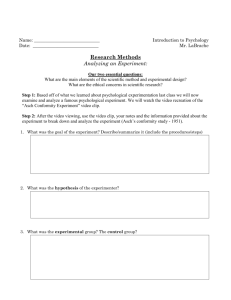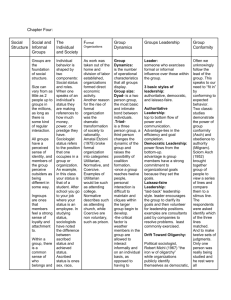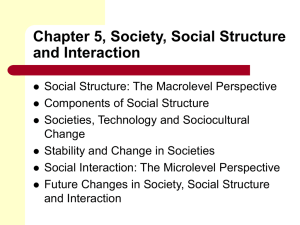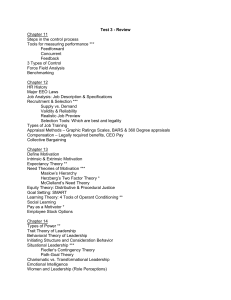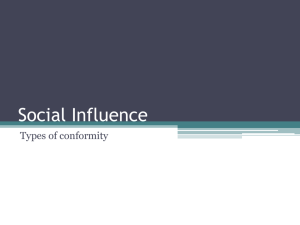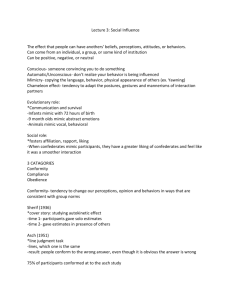Chapter 6 Social Groups and Organizations
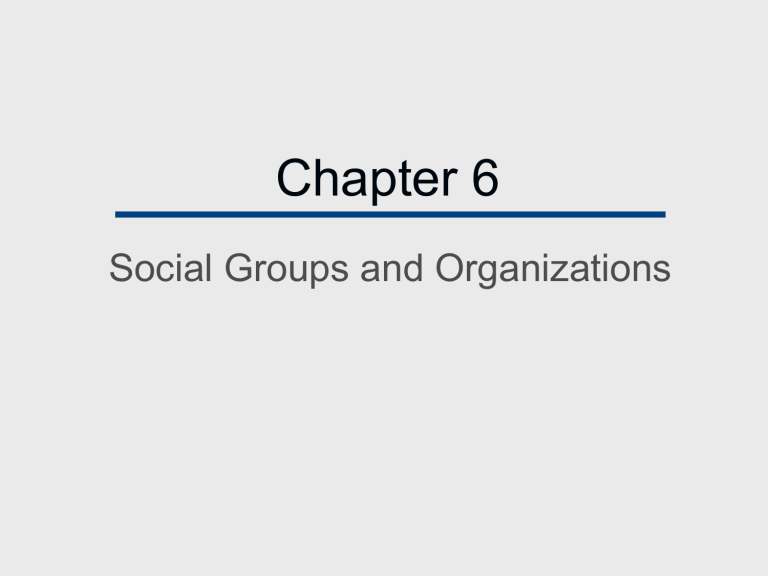
Chapter 6
Social Groups and Organizations
Chapter Outline
The Nature of Groups
Functions of Groups
Small Groups
Large Groups: Associations
Bureaucracy
Social Group
A social group consists of a number of people who have a common identity, some feeling of unity, and certain common goals and shared norms.
In a social group, the individuals interact with one another according to established statuses and roles.
The members develop expectations of proper behavior for people occupying different positions in the social group.
Social Aggregate
A social aggregate is made up of people who temporarily happen to be in physical proximity to each other, but share little else.
Example:
Passengers riding together in one car of a train.
An aggregate ceases to exist when its members are away from one another, unlike a social group.
Question
Strangers waiting in line to check out at a department store would be called a:
A.
B.
social group.
social aggregate.
C.
D.
social collection. social category.
Answer: B
Strangers waiting in line to check out at a department store would be called a social aggregate .
Characteristics of Social
Groups
Permanence beyond meetings of members.
Means for identifying members.
Mechanisms for recruiting new members.
Goals or purposes.
Norms for behavior.
Means for controlling members’ behavior.
Question
How likely would you be to join an organization where membership is determined by race?
A.
B.
Very likely
Somewhat likely
C.
D.
E.
Unsure
Somewhat unlikely
Very unlikely
Primary and Secondary
Groups
Primary groups involve interaction among members who have an emotional investment in one another, who know one another intimately, and who interact as total individuals rather than through specialized roles.
A secondary group is characterized by much less intimacy among members. It usually has specific goals, is formally organized, and is impersonal.
Relationships in Primary and
Secondary Groups
Physical Conditions Social Characteristics
Primary Small number
Long duration
Large number
Shorter duration
Secondary Intrinsic valuation of the relation and the other person
Inclusive knowledge of other person
Feeling of freedom
Operation of informal controls
Extrinsic valuation of the relation and the other person
Limited knowledge of other person
Feeling of constraint
Operation of formal controls
Relationships in Primary and
Secondary Groups
Primary
Sample
Relationships
Friend
Husband
Parent
–friend
Teacher
–wife
–child
–pupil
Secondary Clerk –customer
Announcer –listener
Performer –spectator
Officer –subordinate
Sample Groups
Play group
Family
Village or neighborhood
Work team
Nation
Clerical hierarchy
Professional association
Corporation
Question
Which type of group is the most important to you?
A.
B.
Primary group
Secondary group
Functions of Groups
To function properly, all groups must:
Define their boundaries.
Choose leaders.
Make decisions.
Set goals.
Assign tasks.
Control members’ behavior.
Asch Experiment
Solomon Asch formed groups of 8 people and asked each member to match a line against 3 other lines of varying lengths.
The groups were composed of one real subject and 7 of Asch’s accomplices, who gave incorrect answers during the experiment.
The experiment illustrated how far group members will go to promote conformity.
Asch Experiment
In Asch’s experiment on conformity to group pressure, groups were asked which of the comparison lines
(right) was the same length as the standard line (left).
Question
Asch's experiment was an illustration of how groups:
A.
B.
control members' behavior.
assign tasks.
C.
D.
make decisions.
define boundaries.
Answer: A
Asch's experiment was an illustration of how groups control members' behavior .
Reference Groups
A group or social category that an individual uses to help define beliefs, attitudes, and values and to guide behavior.
Small Group
Many kinds of social groups, such as families, peer groups, and work groups, that actually meet together and contain few enough members so that all members know one another.
Dyad The smallest possible group, it contains two members.
Triad A group consisting of three members.
Large Groups: Associations
Associations are purposefully created specialinterest groups with clearly defined goals and official ways of doing things.
They include government departments and agencies, businesses and factories, labor unions, schools and colleges, fraternal and service groups, hospitals and clinics, and clubs for various hobbies from gardening to collecting antiques.
Formal Structure
Planned, highly institutionalized and clearly defined statuses and role relationships.
Gemeinschaft and
Gesellschaft
In his book Gemeinschaft und Gesellschaft,
Ferdinand Tönnies examined the changes in social relations attributable to the transition from rural to urban society.
In a Gemeinschaft (community), relationships are intimate, cooperative, and personal.
In a Gesellschaft (society), relationships are impersonal and independent.
Mechanical and Organic
Solidarity
According to Durkheim, every society has a collective conscience —a system of fundamental beliefs and values.
Social solidarity emerges from the people’s commitment and conformity to the society’s collective conscience.
Mechanical and Organic
Solidarity
A mechanically integrated society is one in which a society’s collective conscience is strong and there is a great commitment to that collective conscience.
In an organically integrated society, social solidarity depends on the cooperation of individuals in many different positions who perform specialized tasks.
Bureaucracy
A formal, rationally organized social structure with clearly defined patterns of activity in which every series of actions is functionally related to the purposes of the organization.
Weber: Six Characteristics of
Bureaucracies
1.
2.
3.
4.
5.
6.
A clear-cut division of labor.
Hierarchical delegation of power.
Rules and regulations.
Impartiality.
Employment based on technical qualifications.
Distinction between public and private spheres.
The Iron Law of Oligarchy
Robert Michels concluded that the formal organization of bureaucracies leads to oligarchy.
In Oligarchy, organizations eventually come to be dominated by a small self-serving group of people who achieved positions of power and responsibility.
The people in this group become corrupted by their elite positions and make decisions to protect their power rather than to represent the the group.
Quick Quiz
1. An example of a social group would be:
A.
people who are left-handed.
B.
C.
D.
a baseball team.
people waiting for a bus. the upper class.
Answer: B
An example of a social group would be a baseball team .
2. Which of the following is a characteristic of social groups?
A.
Shared goals or purposes.
B.
C.
D.
Means for controlling members' behavior.
Means for identifying members.
All of these choices are correct.
Answer: D
The following are characteristics of social groups:
Shared goals or purposes.
Means for controlling members' behavior.
Means for identifying members.
3. Uniforms, school ties, and skin color all serve what function of groups?
A.
B.
defining group boundaries controlling members' behavior
C.
D.
selecting leadership assigning specialized tasks
Answer: A
Uniforms, school ties, and skin color all serve to define group boundaries .
4. Gemeinschaft society is characterized by:
A.
little sense of identification with others.
B.
C.
the good of the group over the good of the individual.
a high degree of competition between individuals.
D.
formal contracts that govern economic exchanges.
Answer: B
Gemeinschaft society is characterized by the good of the group over the good of the individual .
5. Under the iron rule of oligarchy, organizations eventually:
A.
become more idealistic than when they began.
B.
C.
become dominated by a self-serving group of people who have achieved positions of power.
have many responsibilities and duties.
D.
strive to maintain their democratic means of operation.
Answer: B
Under the iron rule of oligarchy, organizations eventually become dominated by a self-serving group of people who have achieved positions of power .
